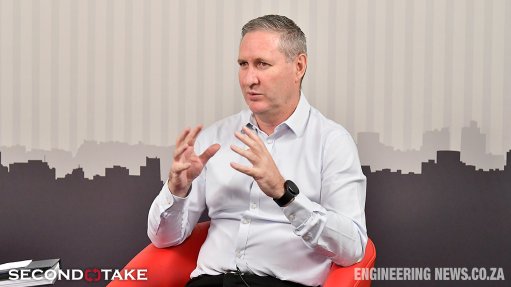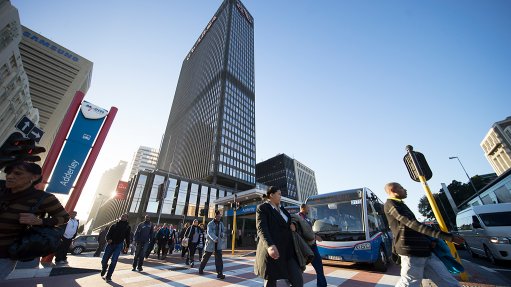CSIR's new strategy aims to tap into private-sector prospects
Council for Scientific and Industrial Research (CSIR) CEO Dr Thulani Dlamini has announced both a new strategy and a radical restructuring of South Africa's world-renowned science council. The aim of the new strategy and structure was to strengthen the industrial research activities of the organisation and create closer ties with industry.
The new set-up was the result of a programme designated Project Synapse, which was started in August 2017 (Dlamini took over as CSIR CEO in February 2017.)
In his address to the media, CSIR board chairperson Professor Thokozani Majozi stated that the purpose of Project Synapse was to strengthen the CSIR's support for, and development of, South African industry. "Project Synapse is a well thought-out process," he reported.
The CSIR would contribute to industrial development, including the development of new industries as well as by supporting existing industries, he added. It would also seek closer ties with private-sector industry. Much of the CSIR's current contract work was for government departments and State-owned companies. In future, the science council had to properly tap into private-sector opportunities. "We can't rely on government," said Majozi.
Although the CSIR could not, on its own, solve the country's socio-economic problems, it could, he affirmed, make a significant contribution to their solution. In particular, it could create new jobs by creating new industries and supporting existing industries.
In his address, Dlamini emphasised the agency's mandate, which was to undertake directed and especially multidisciplinary research and technological innovation, to foster scientific and industrial research and development, and to contribute to the improvement of the quality of life of the South African people.
He also quoted the new vision for the science council: "We are accelerators of socio-economic prosperity in South Africa through leading innovation," as well as its mission statement: "Collaboratively innovating and localising technologies while providing knowledge solutions for the inclusive and sustainable advancement of industry and society."
There was a need to ensure a balance between scientific and industrial research. "Scientific research at the CSIR should lead to industrial development," he affirmed. The agency would work with private-sector industry, State-owned companies, academia, Government and other partners in innovation. It would develop new technologies locally and localise technologies (especially those of the Fourth Industrial Revolution) developed overseas.
To execute this strategy, the research, development and innovation activities of the CSIR were being re-grouped into nine "Technology Sector Clusters". The nine Clusters were – Future Production: Chemicals; Future Production: Manufacturing; Future Production: Mining; NextGen Health; NextGen Enterprises and Institutions; Smart Logistics; Smart Places; and, Defence and Security. Each Cluster would have its own head office or "Centre" plus a number of "Impact Areas". In turn, each Impact Area would be subdivided into a number of Research Groups.
Upwards, the nine Clusters would come under three Divisions, namely Chemicals, Agriculture, Food and Health; Mining, Manufacturing, Defence and Security; and, Natural Resources, Enabling Infrastructure, Public and Professional Services. In addition to their respective Clusters, each of these Divisions would also contain a Business Development and Commercialisation unit. (There would also be supporting Divisions: Legal, Compliance and Business Enablement; Human Capital; Finance; and Business Excellence and Integration.)
"Implementation of the new structure started on 1 April this year," said Dlamini. "We are now going through the change process. We now have the Clusters. We don't have the [previous] Operating Units any more. We have appointed the Divisional Group Executives. But the change process associated with the new strategy will take some time." It was expected that the process would finally be completed some 18 to 24 months after it had begun.
Highlights
The CSIR cannot rely on the Government and must tap into private-sector opportunities
CEO: scientific research at the CSIR should lead to industrial development
Comments
Press Office
Announcements
What's On
Subscribe to improve your user experience...
Option 1 (equivalent of R125 a month):
Receive a weekly copy of Creamer Media's Engineering News & Mining Weekly magazine
(print copy for those in South Africa and e-magazine for those outside of South Africa)
Receive daily email newsletters
Access to full search results
Access archive of magazine back copies
Access to Projects in Progress
Access to ONE Research Report of your choice in PDF format
Option 2 (equivalent of R375 a month):
All benefits from Option 1
PLUS
Access to Creamer Media's Research Channel Africa for ALL Research Reports, in PDF format, on various industrial and mining sectors
including Electricity; Water; Energy Transition; Hydrogen; Roads, Rail and Ports; Coal; Gold; Platinum; Battery Metals; etc.
Already a subscriber?
Forgotten your password?
Receive weekly copy of Creamer Media's Engineering News & Mining Weekly magazine (print copy for those in South Africa and e-magazine for those outside of South Africa)
➕
Recieve daily email newsletters
➕
Access to full search results
➕
Access archive of magazine back copies
➕
Access to Projects in Progress
➕
Access to ONE Research Report of your choice in PDF format
RESEARCH CHANNEL AFRICA
R4500 (equivalent of R375 a month)
SUBSCRIBEAll benefits from Option 1
➕
Access to Creamer Media's Research Channel Africa for ALL Research Reports on various industrial and mining sectors, in PDF format, including on:
Electricity
➕
Water
➕
Energy Transition
➕
Hydrogen
➕
Roads, Rail and Ports
➕
Coal
➕
Gold
➕
Platinum
➕
Battery Metals
➕
etc.
Receive all benefits from Option 1 or Option 2 delivered to numerous people at your company
➕
Multiple User names and Passwords for simultaneous log-ins
➕
Intranet integration access to all in your organisation


















